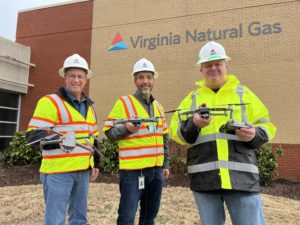
by DRONELIFE Staff Writer Ian M. Crosby
Virginia Natural Gas (VNG) is set to become the first natural gas utility in the state to deploy Unmanned Aerial Vehicles (UAVs) for the inspection of gas pipelines. Self-dispatched Mavic 2 Pro drone will fly across Hampton Roads, northern James and New Kent Counties for the inspection of critical infrastructure and over 5,500 miles of gas pipeline. VNG will also initiate a pilot program for its sister companies in Illinois, Georgia and Tennessee that all fall under VNG’s parent company, Southern Company Gas (SCG). This new project builds on a program established in 2015 by SCG parent Southern Company.
“Southern Company, and now Virginia Natural Gas, is leading the energy industry in deploying state-of-the-art drone operation technology and elevating their processes,” said Dean Barefield, Unmanned Aerial Services program manager at Southern Company. “We see parallels between our electric and gas utilities and the ability to integrate that technology. The addition of drones to the day-to-day operations at VNG will offer a cost-effective platform for pipeline inspection while increasing efficiency and safety due to their availability, range and ease of operation.”
Previous methods of pipeline inspection have been less efficient, and at times caused safety concerns due to the surrounding environment. Despite running underground, natural gas pipelines are accessed from above the surface for maintenance and inspection. Obstacles such as vegetation can often make the pipeline difficult to access for workers.
“VNG is always looking at new, innovative ways to help us continue to provide reliable service to our customers,” said Zack Gravely, Asset Protection specialist and one of three new FAA-certified pilots who will be operating the drones. “Drones are ideally suited for inspecting equipment because they can safely and quickly deliver high-quality photos and videos of our system in a way that can minimize environmental impact and inconvenience for customers along any rights-of-way. This technology will be another tool in our arsenal.”
Drones outfitted with a visual or infrared camera are able to be deployed to navigate and patrol a segment of pipeline and to identify and capture image and video.
“I appreciated the opportunity to be part of the initial program and combine my love of flying while further developing my career,” said VNG Construction supervisor Randall “Ness” Peacock. “To be on the ground level of this program and help define what it will look like for VNG and for our peers was something I knew I wanted to be involved with.”
“We all have different ideas and are trying to put together a solid program,” said Engineer and Quality Assurance specialist Kenny LeSueur, who is in charge of developing a program to incorporate adaptable drone technology for Southern Company Gas. “Drones will give us the flexibility to perform a variety of higher quality inspections due to their ability to fly closer to pipelines, and safety of operation. For example, when we inspect bridges, we will no longer have to be close to the water source, such as rivers or streams, so it will increase the safety for those in the field as well.”
“There will be situations where the drone will be an extension of the team in the field,” added Peacock. “The real value is when you combine their abilities with the experience of the team.”
Read more about drones in oil and gas:
- Hydrogen-fueled Drones Will Inspect U.S. Gas Pipeline
- Inside the First Truly BVLOS Quadcopter Drone Flight Without Ground Observers – A 4 Mile Linear Inspection Along the Trans-Alaska Pipeline
- Professional Viewpoint: How Drones Overcome Major Obstacles in Pipeline Surveys
- SolSpec Launches Innovative Drone Solutions for Gas, Oil Pipelines
Miriam McNabb is the Editor-in-Chief of DRONELIFE and CEO of JobForDrones, a professional drone services marketplace, and a fascinated observer of the emerging drone industry and the regulatory environment for drones. Miriam has penned over 3,000 articles focused on the commercial drone space and is an international speaker and recognized figure in the industry. Miriam has a degree from the University of Chicago and over 20 years of experience in high tech sales and marketing for new technologies.
For drone industry consulting or writing, Email Miriam.
TWITTER:@spaldingbarker
Subscribe to DroneLife here.
